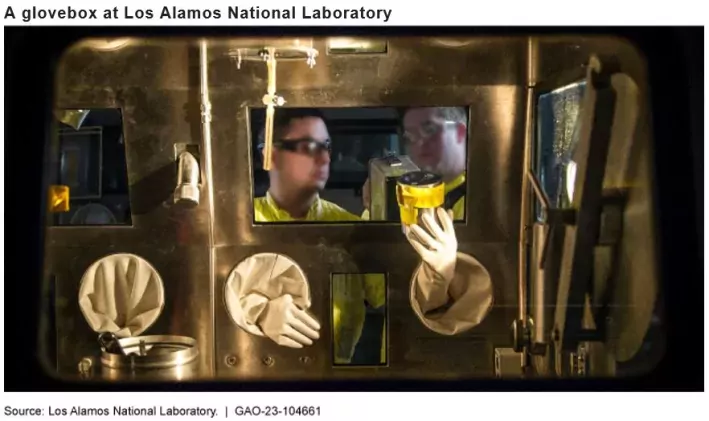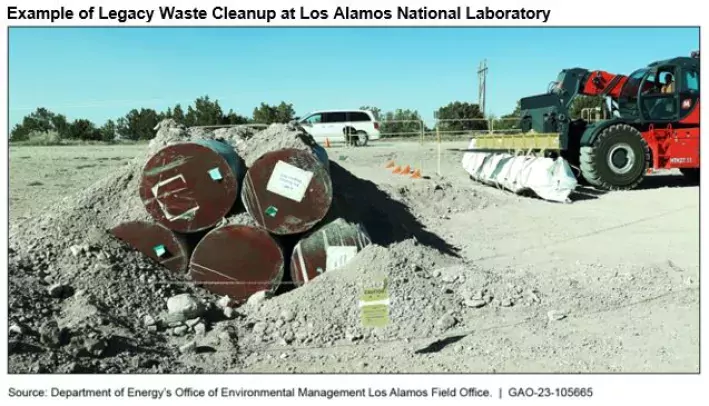The Legacy of Oppenheimer’s Nuclear Research at Los Alamos
With 13 Academy Award nominations, Oppenheimer is favored to win big at this year’s Oscars on Sunday. The compelling film dramatizes one man’s struggle living with his legacy—J. Robert Oppenheimer, the “father of the atomic bomb.”
But the real-life legacy of nuclear weapon development for the U.S. stretches far beyond the 1940s and Oppenheimer. More than 80 years later, the federal government and communities surrounding the original sites used to build the bomb continue to struggle with nuclear waste cleanup.
Today’s WatchBlog post looks at the status of cleanup efforts at Los Alamos, New Mexico—a nuclear site heavily featured in the Oppenheimer movie.
Image

Los Alamos
Much of the movie Oppenheimer takes place in Los Alamos, where in 1943 American scientists and military officials met to build and test the first atomic bombs. Over the years, these activities have necessitated cleanup in three areas: environmental remediation (soil and groundwater), nuclear legacy waste removal, and contaminated buildings at the site. Environmental risks and contamination occurred not just during World War II efforts, but afterward as well.
In July, we reported about the Department of Energy’s (DOE’s) effort to manage Los Alamos cleanup. Those leading this effort estimate it would cost about $7 billion to complete remaining cleanup activities there.
- Environmental remediation. About $2.3 billion has been spent on environmental remediation activities since cleanup efforts began in 1997. As of March 2023, the remaining environmental remediation activities were estimated to cost about $1.6 billion more. These efforts include investigating and remediating contaminated soil in certain watersheds and canyons across Los Alamos.
- Legacy waste. DOE has spent $1.5 billion processing and shipping legacy nuclear waste off-site since cleanup began in 1997. This includes 7,000 cubic meters, or 67%, of the known aboveground legacy waste. Removing the remaining legacy waste at Los Alamos is estimated to cost $753 million.
- Contaminated buildings. DOE is also working to deactivate and decommission facilities at Los Alamos—including a Cold War-era plutonium-processing facility and a tritium research facility. Almost all aboveground structures, water tanks, and sewage treatment facilities have been demolished. As of March 2023, DOE was continuing its investigation of how best to demolish the remaining buildings. It estimated this effort would cost about $58 million to complete. But some officials told us estimates were out of date and costs could be higher.
Image

Back in July, DOE officials had drafted a new plan for cleaning up Los Alamos, which included updated cost estimates. But we found that DOE hadn’t taken a comprehensive approach to prioritizing cleanup activities at the site. For example, DOE hadn’t documented different options it could take to meet cleanup goals, which means DOE can’t be assured it is best prioritizing those activities. In our July report, we made six recommendations to DOE on ways to improve its efforts at Los Alamos. Check out our full report to learn more.
Our work on other nuclear sites and issues
GAO has a broad portfolio of work on nuclear weapons development, waste disposal, nuclear energy, and more.
This includes reports on other important Oppenheimer-era sites such as:
- Hanford, Washington, which was the location of reactors and processing plants used to produce the plutonium in the first atomic bombs. DOE is working to treat and dispose of about 54 million gallons of radioactive and hazardous waste stored in tanks at Hanford. This effort could take decades and is estimated by DOE to cost between $300 billion and $640 billion.
- Oak Ridge, Tennessee, which—along with neighboring Paducah, Kentucky and Portsmouth, Ohio—is contaminated with radioactive and hazardous materials that could cost billions to cleanup. DOE had spent about $15.5 billion to clean up these areas, as of 2018. It estimated another $28 billion may be needed.
Learn more about our work on nuclear-related topics at GAO.gov.
- GAO’s fact-based, nonpartisan information helps Congress and federal agencies improve government. The WatchBlog lets us contextualize GAO’s work a little more for the public. Check out more of our posts at GAO.gov/blog.





